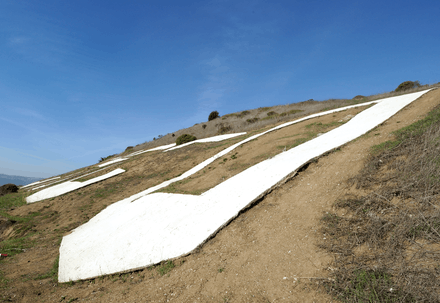South San Francisco hillside sign
|
South San Francisco Hillside Sign | |
|
| |
 South San Francisco hillside sign  South San Francisco hillside sign  South San Francisco hillside sign | |
| Location | Sign Hill Park, North of Park Way, South San Francisco, California |
|---|---|
| Coordinates | 37°39′41″N 122°25′08″W / 37.6614238°N 122.4189591°WCoordinates: 37°39′41″N 122°25′08″W / 37.6614238°N 122.4189591°W |
| Area | 41 acres (17 ha) |
| Architect | Klassen, Robert A.; Kneese, George A. |
| NRHP reference # | 96000761[1] |
| Added to NRHP | July 11, 1996 |
The South San Francisco Hillside Sign is a historic sign on a hillside overlooking the city of South San Francisco in San Mateo County, California. It was created in the 1920s and is listed on the National Register of Historic Places.[2] The sign is the main feature of Sign Hill Park, a city park which provides 30 acres (12 ha) of open space, almost 2 miles (3.2 km) of hiking trails, and access to the letters of the sign itself.[3]
Easily visible to drivers on northbound U.S. 101,[4] the sign spells out "SOUTH SAN FRANCISCO THE INDUSTRIAL CITY" in white-painted concrete letters. The letters are set on the south side of a steep 581-foot (177 m) hill, part of the San Bruno Mountains, overlooking the city. In order to create the appearance of straight, uniformly sized type despite the varied contour of the hillside, the letters are laid out anamorphically, ranging in height from 48 to 65 feet (15 to 20 m).[5]
History
An early version of the sign was put on the hillside in 1923 and the current, permanent sign was created in 1929. The sign is cited as a prime example of "civic boosterism"; the intention was to advertise the city's welcoming attitude toward industry. Its location was chosen so as to be visible from the main north-south highways El Camino Real and the Bayshore Highway, as well as from the train and the nearby Mills Field airfield (now San Francisco International Airport). The sign was originally proposed, and the first sign was placed, by the South San Francisco Chamber of Commerce. The $5,000 cost of the second, permanent sign was funded by a special property tax assessment approved by the voters.[2]

.jpg)
At that time the city "was the smokestack capital of the Peninsula."[6] There were steel and cement plants, meat packers, shipbuilders and many other industrial plants; major companies included W. P. Fuller Paint, Western Pipe and Steel Company, the Metal and Thermit Corporation, and the Western Meat Company. A shipbuilding yard on Oyster Point built 45 ships in 48 months for use in World War II.[7]
Following World War II the city's economy transitioned from heavy industry to light industry and then to high-tech and biotech companies. The city's largest employer is now Genentech, which has promoted South San Francisco as "the birthplace of biotechnology".[7] As a result of this shift away from industry as the city's economic focus, there was a movement during the 1980s to tear down the sign or change it to "the industrious city". In response, the city's Historic Preservation Commission and Historical Society persuaded the City Council to seek historic designation, which was awarded in 1996.[6]
See also
References
- ↑ National Park Service (2010-07-09). "National Register Information System". National Register of Historic Places. National Park Service.
- 1 2 "National Register of Historic Places Continuation Sheet". National Park Service. Retrieved 2 April 2013.
- ↑ "Sign Hill". City of South San Francisco. Retrieved 2 April 2013.
- ↑ Patty, Robyn (October 21, 2010). "South City's Most Prominent Sign Points the Way to a Good Hike - South San Francisco, CA Patch". South San Francisco Patch. Patch Media. Retrieved June 8, 2017.
Heading north on Highway 101 to San Francisco, everyone sees the huge white letters on Sign Hill alerting drivers that they've reached "South San Francisco The Industrial City."
- ↑ "South San Francisco Hillside Sign". National Register of Historic Places in San Mateo County. noehill.com. Retrieved 2 April 2013.
- 1 2 Simon, Mark (May 7, 1996). "South S.F. Sign Wins Status; Famous hillside slogan to be historic landmark". San Francisco Chronicle. Retrieved 2 April 2013.
- 1 2 Pellissier, Hank (November 6, 2010). "Local Intelligence: Sign Hill". The New York Times. Retrieved 2 April 2013.